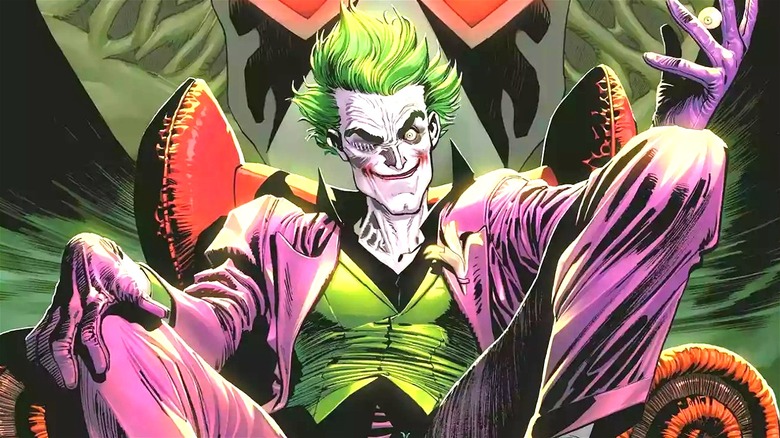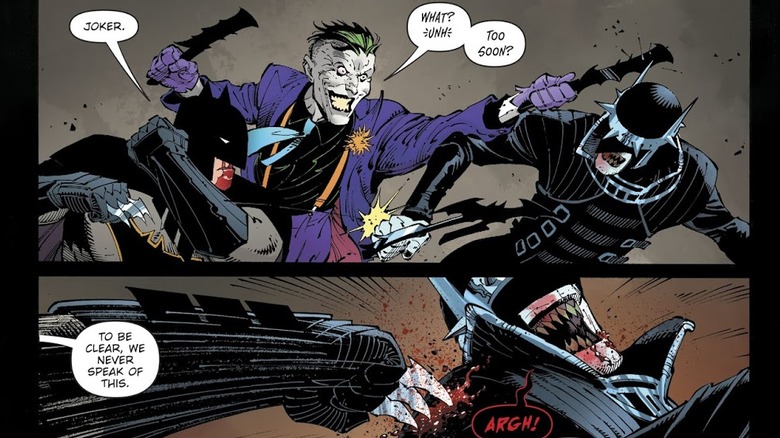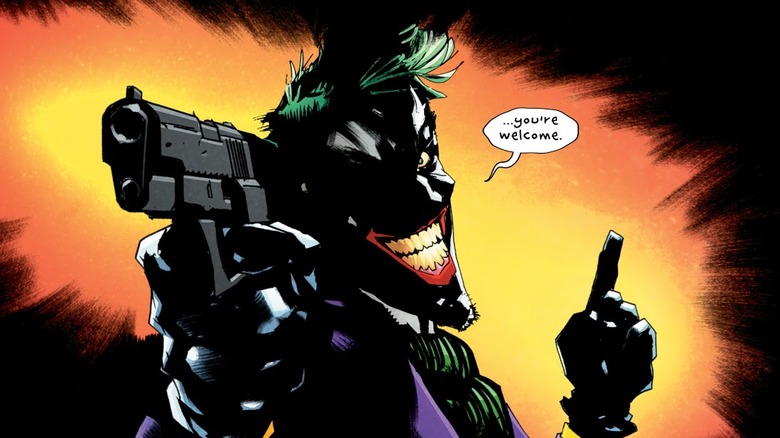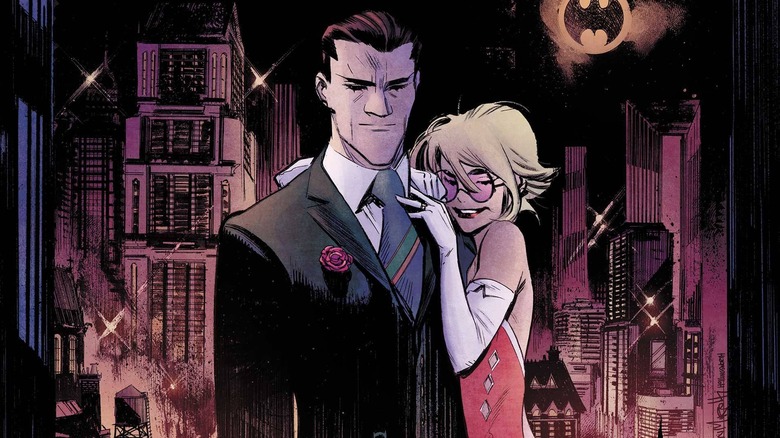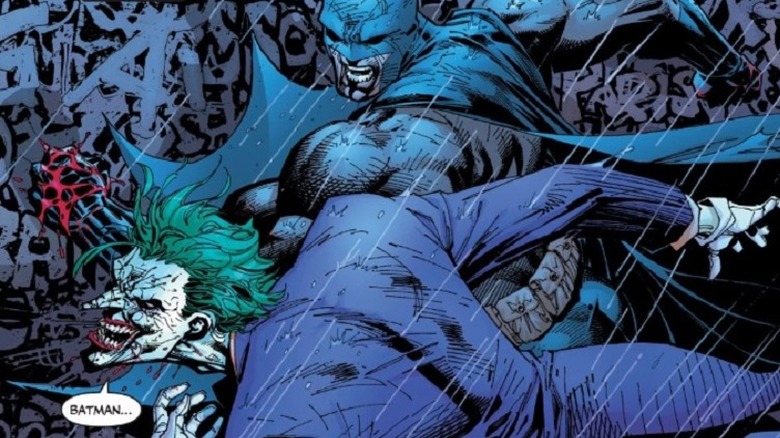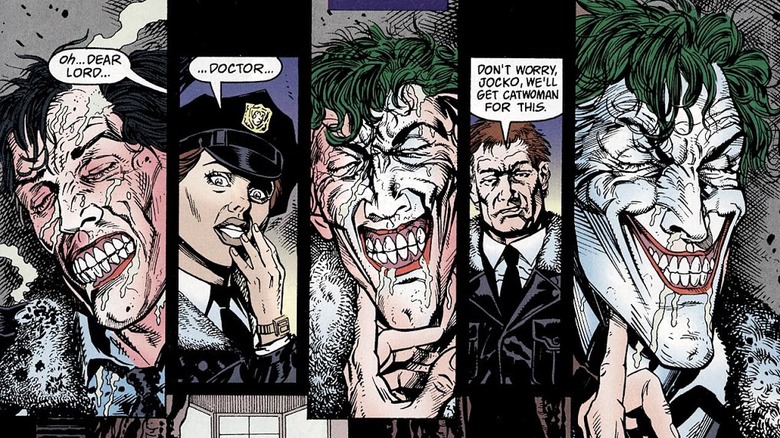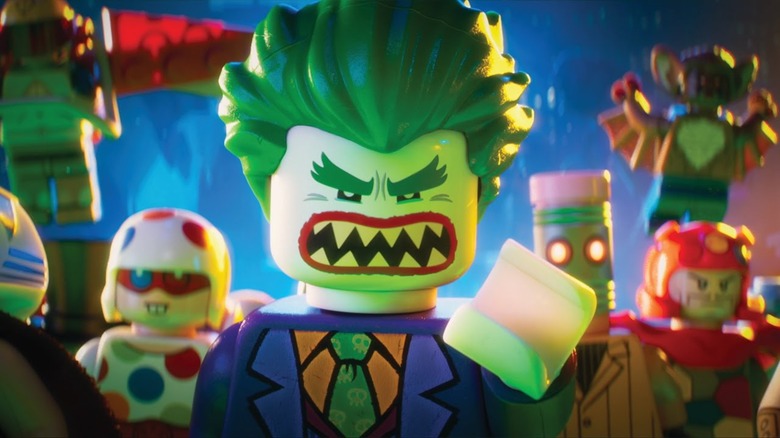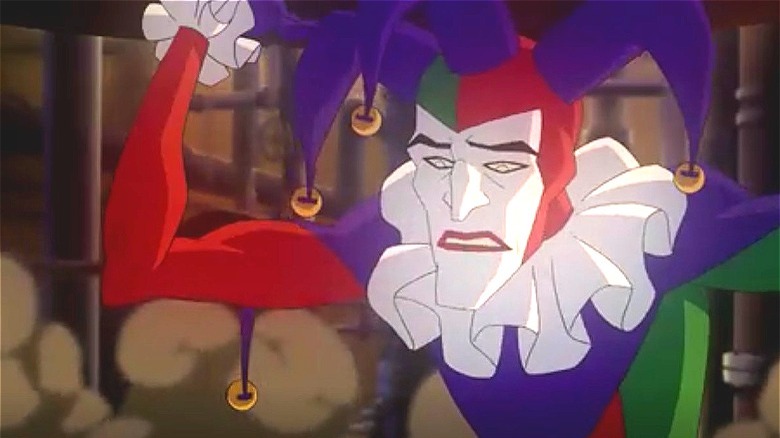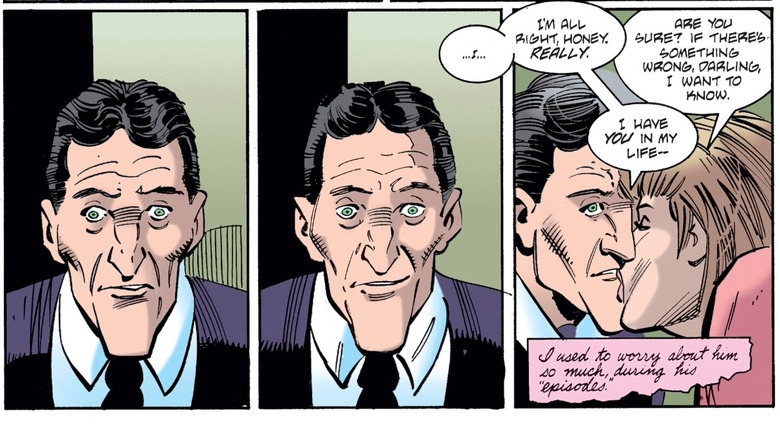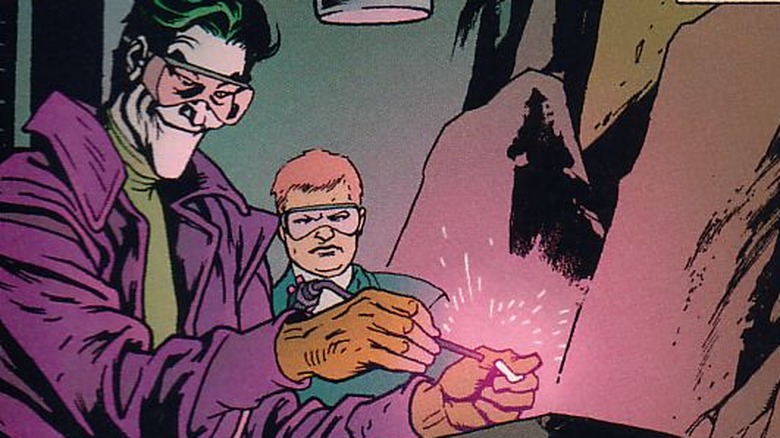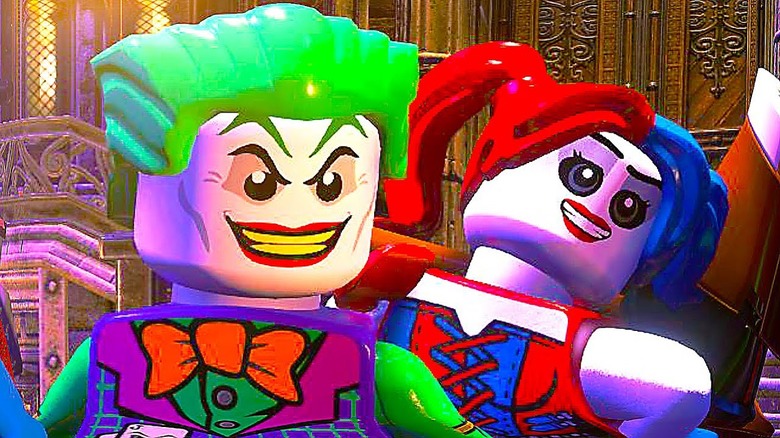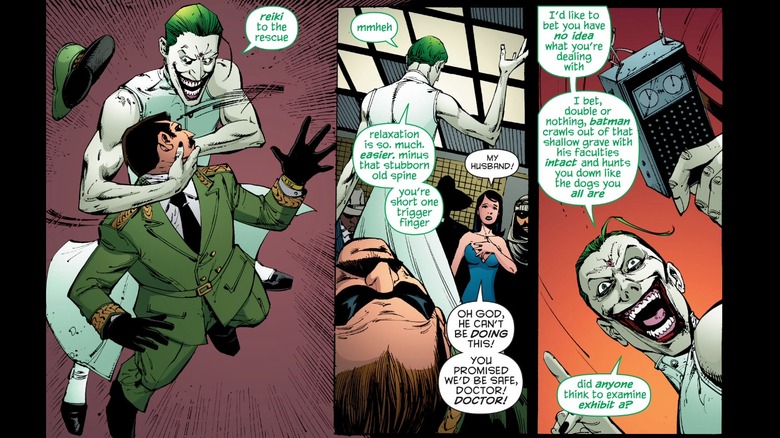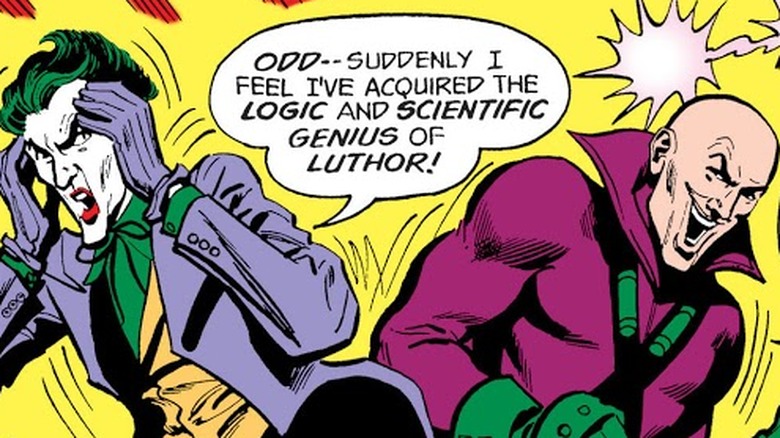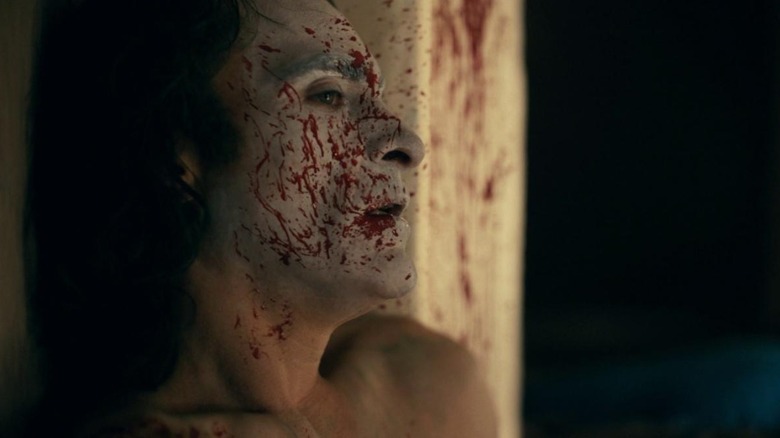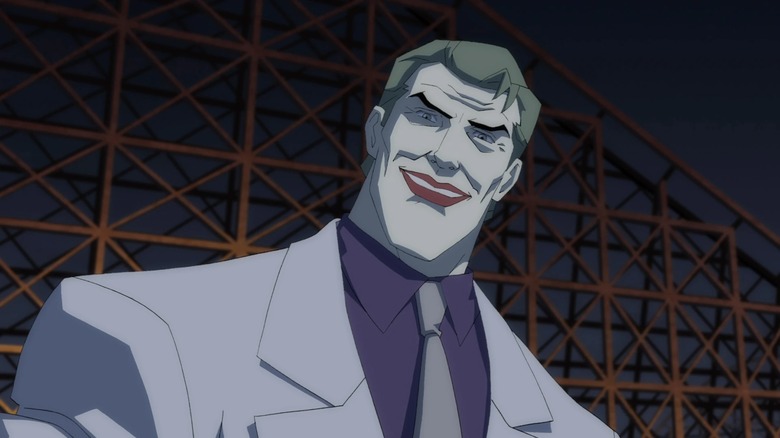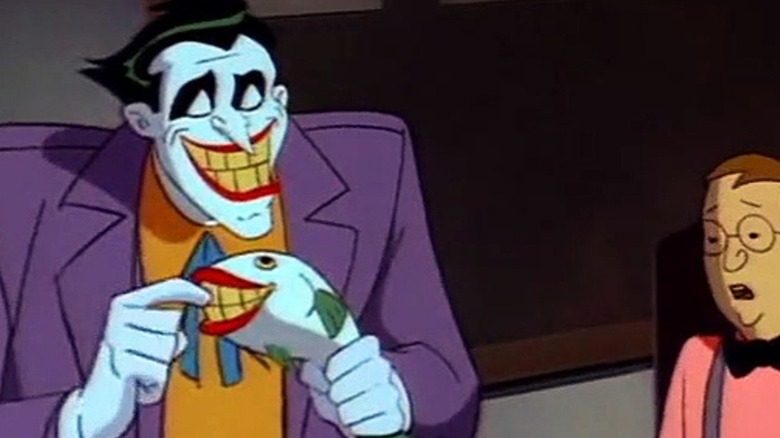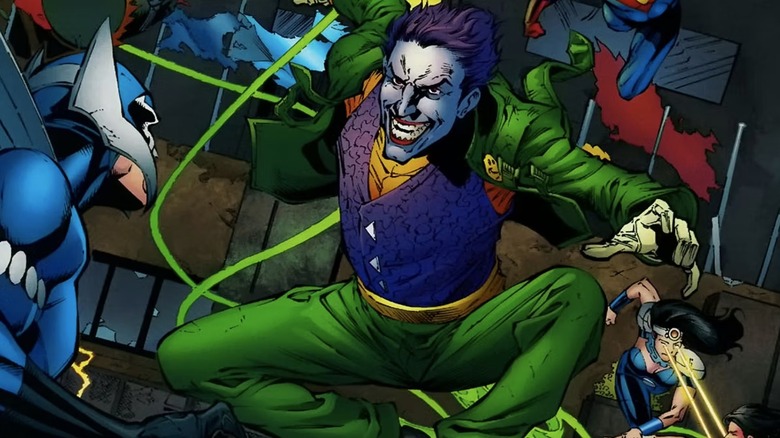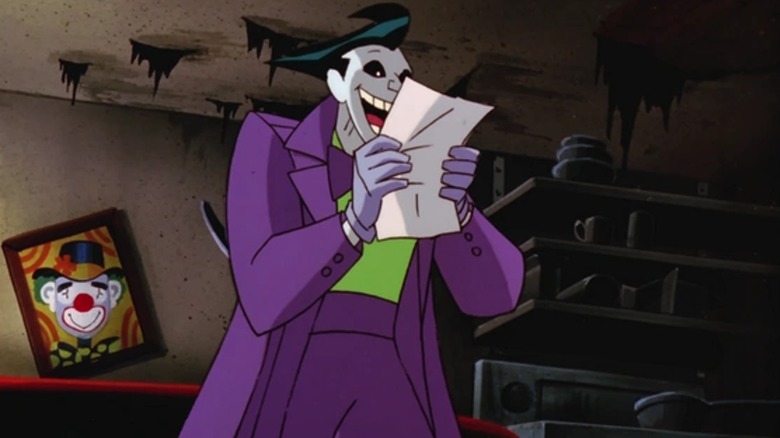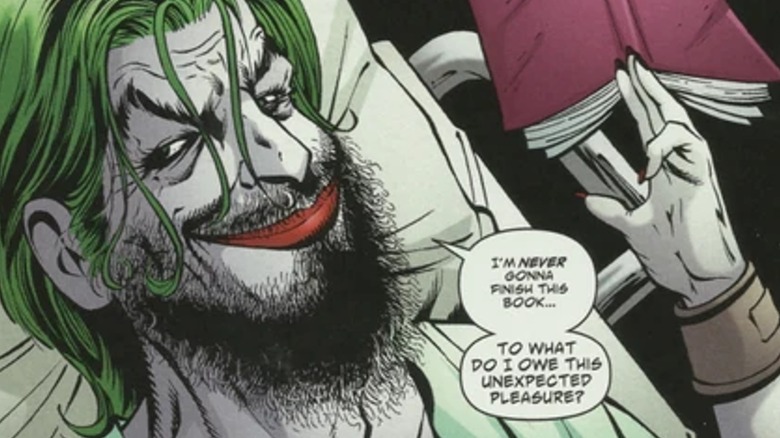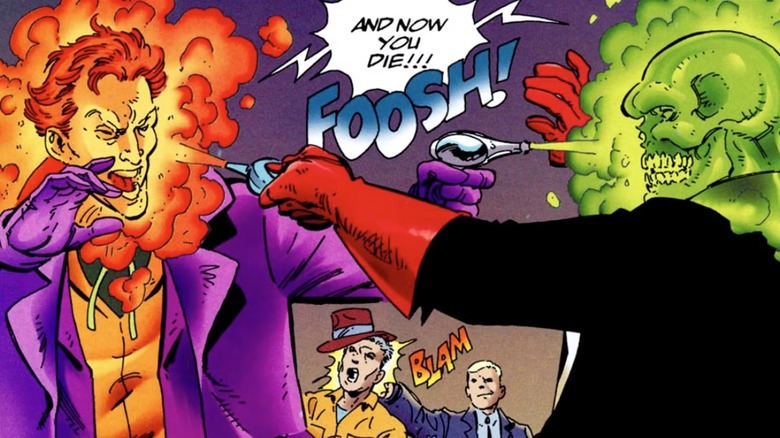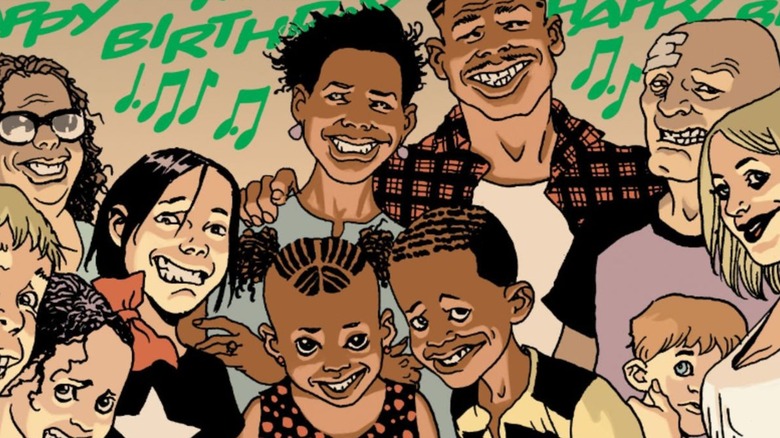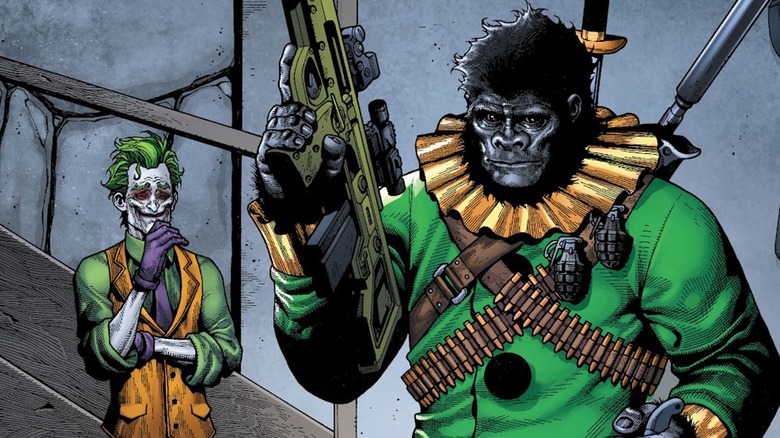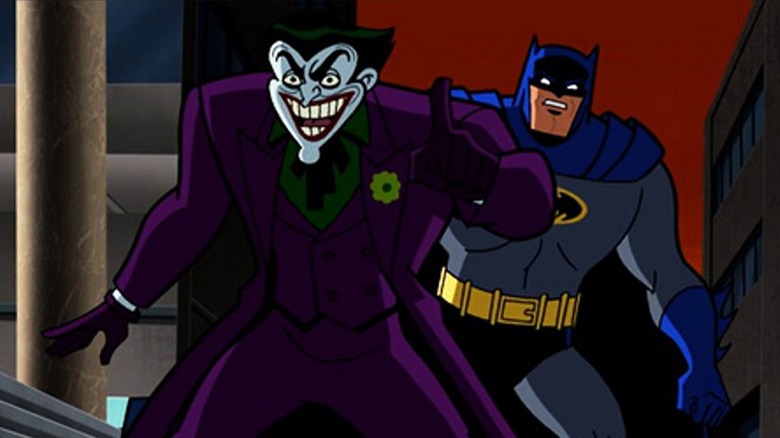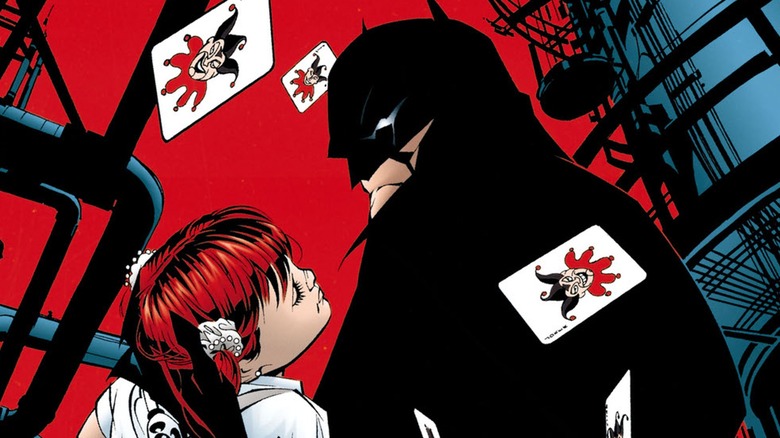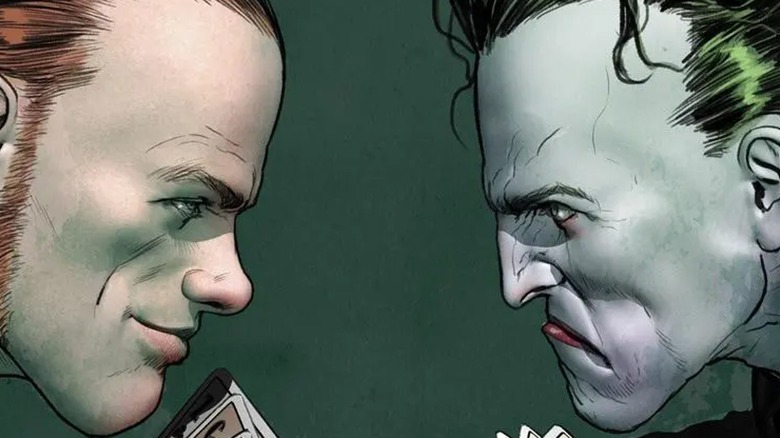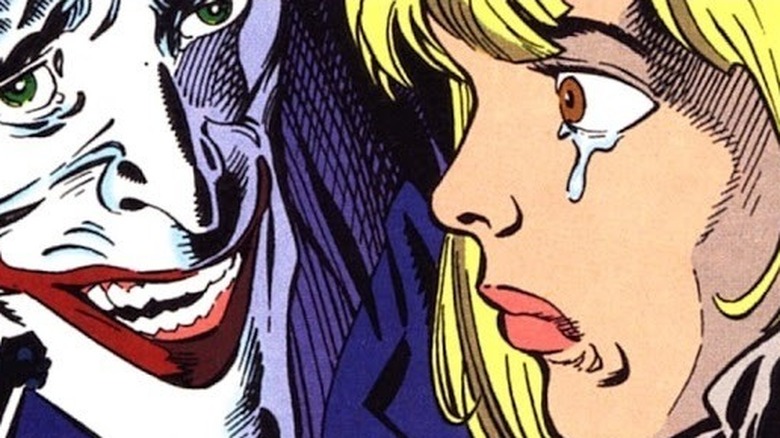Times The Joker Was Actually Right
Whether it's on the big screen, the small screen, the comic book panels, or any other media, the Joker isn't known for his rational and morally sound decision-making. He's a kill-crazy, cackling psychotic whose very presence is a nightmare. You'd think of all the professions you might pursue in Gotham City, at this point, stand-up comic would be any sane person's last choice. Not because the place couldn't use a few laughs — any city with all those looming stone gargoyles needs as many chuckles as it can get — but because you'd think of all the noises any Gothamite might want to hear, laughter would be the last.
Still, having premiered in 1940's "Batman" #1, the Clown Prince of Crime has been around for over eight decades. And anyone who's been around that long is bound to do something right. It might be by accident, it might be for purely selfish reasons, and it might be for utterly insane reasons. As much as he wants to see Batman defeated, for example, Joker wants to be the one to make that defeat a reality. So every now and then, he trips up other bad guys just to make sure Batman's doom doesn't get poached from him.
As difficult as it might be to imagine, here are some times that the Joker was actually right.
Joker helped defeat the Batman Who Laughs
In the 2017-2018 DC Comics line-wide event "Dark Nights: Metal," DC's heroes face antagonists from the Dark Multiverse. In particular, they're assaulted by evil, lethally violent versions of Batman, and perhaps the most vicious of them all is the Batman Who Laughs — a black leather-clad, bone white-skinned Bruce Wayne with a spiked metal headband covering his eyes. The Batman Who Laughs is a version of Bruce Wayne driven mad after murdering the Joker, essentially a merging of the two characters.
When Batman confronts his dark echo in 2018's "Dark Nights: Metal" #6, he has help. The villain overpowers him, but the Joker appears and shoots Batman Who Laughs from behind while he's monologuing. Together, Batman and Joker are able to defeat the darker Bruce Wayne, and Joker doesn't hold back. He uses an improvised cleaver made from a bat-a-rang to chop off the dark Batman's fingers from his left hand.
There isn't any discussion of exactly why Joker is willing to help Batman, but it's not difficult to guess a few motivations. The fact that a Batman exists who was driven mad after committing murder must be too delicious a temptation for Joker to resist meeting. Plus, he's unlikely to get another opportunity to maim a Batman with another Batman helping him. The absurdity of the situation is probably enough to keep the Joker laughing for a few weeks at least.
The Joker saved Batman from himself
The villainous Batman Who Laughs was first introduced in "Dark Nights: Metal," but after his defeat, he returned for a few appearances in 2018 issues of "Justice League" before finally showing up in his own mini-series alongside another alternate reality Bruce Wayne, the gun-toting Grim Knight.
This time around, the Joker forces a new strategy upon Batman. At the end of "Batman Who Laughs" #1, the Joker fools Batman into thinking he's looking for protection. Instead, the Joker enters the Batcave and shoots himself — infecting Batman with his Joker toxin. As he passes out, the Joker says "The only way you'll beat him... is to become him." The issue ends with Batman taking on Joker's bone-white skin and hyena-like laugh. Initially, Batman does everything he can to fight Joker's toxin. By the end of the third issue he decides the Joker's right and he needs to see the world from the Batman Who Laughs' point of view. In spite of Alfred's passionate objections, Batman stops fighting the Joker toxin and allows it to run its course.
Batman manages to defeat the Batman Who Laughs in the final issue of the miniseries. Once the darker Bruce Wayne is defeated, Batman loses his battle with the toxin and attempts to beat the now helpless Batman Who Laughs to death. Alfred tries and fails to stop the hero, who is loudly thanking the prone Batman Who Laughs as he pounds on him. That's when the Joker appears, pointing a gun at his old nemesis. He tells him "You're welcome," and fires. Joker's shot stops Batman without killing him, giving Alfred the chance to clear Bruce's system of the toxin.
Joker became a white knight
In 2017-2018, writer/artist Sean Murphy showed us a different side of the Batman mythos in the mini-series "Batman: White Knight." The series doesn't exactly turn the Batman/Joker conflict on its head, but it shines a light on Batman's hypocrisy.
Unlike the Joker of DC's prime continuity, this Joker shares the alter ego of the one shown in Tim Burton's game-changing "Batman" movie, Jack Napier, but his white skin is the result of make-up rather than a fall into a chemical vat. "White Knight" opens with Batman capturing Joker yet again, when the clown-faced criminal tries to rob a building containing pills he wants to treat his mental health. After beating Joker to a pulp, Batman forces an entire bottle of the pills down his throat, which temporarily cures Jack Napier of his psychosis. A sane Joker manages to legally free himself from Arkham Asylum, arguing that Batman and the rest of Gotham's law enforcement never try to handle his mental illness with treatment, but instead go right to violence. He's freed, becomes one of Gotham's most popular citizens, and eventually helps to save Gotham from a super-weapon.
The Joker of "White Knight" isn't squeaky clean, and he isn't above dark means to justify his ends. Using the Mad Hatter's technology and Clayface's unique physiology, Napier secretly takes mental control over almost all of Gotham's signature bad guys and uses them for what he sees as noble goals. Tragically, he transforms back into the Joker at the end of the series, but not without saving Gotham first.
The real villain framed the Joker in Hush
One of the most well-remembered Batman stories of the 21st century is "Hush" by Jeph Loeb and Jim Lee. A hefty chunk of the Dark Knight's rogue's gallery shows up in the story. There's Riddler, Poison Ivy, Killer Croc, Ra's al Ghul, Scarecrow, Harley Quinn, and Clayface. Batman even has a throw-down with a mind-controlled Superman. Of course, no epic Batman tale could be complete without the Joker, and the Clown Prince's appearance is memorable, even though he ultimately proves to not be the villain of the story.
After a tussle with Harley Quinn in 2003's "Batman" #613, the issue ends with a gun-toting Joker crouching over what appears to be the corpse of Bruce Wayne's childhood friend, Tommy Elliot. In spite of appearances, we eventually learn that Joker didn't shoot Elliot, and in fact, Elliot isn't dead. Instead, he's the villain whose name the story comes from, Hush. But seeing Joker over an apparently lifeless Tommy Elliot is too much for Batman, and he casts aside his usual restraint, beating Joker bloody and ultimately deciding to murder him. Catwoman steps in to stop him, but it's only the intervention of James Gordon, who holds his gun to Batman's head, that saves the Joker's life.
Now, the fact that the Joker didn't kill Tommy Elliot doesn't exactly put him on the side of the angels, but at least this one time when he tells Batman, "I'm innocent," he's right.
Joker was a detective who brought Batman to justice
In 1996's "Catwoman Annual" #3, we visit an alternate reality where the Joker is the good guy chasing down the criminal duo Batman and one of the craziest versions of Catwoman. In the first few pages, we see Officer Jock Bozer — a police officer going after Batman and Catwoman — get kicked in the face by Catwoman and fall into a vat of chemicals that transforms him into the Joker.
Rather than going nuts, this world's Joker becomes Gotham's best cop, and eventually, he's promoted to police commissioner. In the course of pursuing Batman and Catwoman, Joker finds an ally in the reporter Edward Nigma, who Batman and Catwoman try and fail to murder when they fear he's getting too close to figuring out who they are. The issue ends with the deaths of both Batman and Catwoman, as their son Dick Grayson betrays them to Commissioner Joker.
Joker and Riddler later became police partners in the comics as something of a tribute to "Catwoman Annual" #3, but the partnership is actually part of DC's main continuity. In 2019's "Batman" #75, the "City of Bane" storyline finds that Batman's back-breaking villain has taken control of Gotham and made the rest of the Dark Knight's rogue's gallery his lieutenants. The comic opens with Detectives Joker and Riddler investigating murders by Two-Face and reporting to the new Gotham police commissioner, Hugo Strange.
Joker did the right thing in The LEGO Batman Movie
In 2017's "The LEGO Batman Movie," the Joker (Zach Galifianakis) isn't happy with the Dark Knight, though this time things are personal in a, well, kind of awkward way. Early in the film, Batman (Will Arnett) assures Joker that he is not, in fact, his chief enemy. The conversation is purposely designed to sound like an argument between lovers. Batman tells the Clown Prince that he doesn't mean anything to him. Joker's lips tremble as he struggles not to break out in tears.
The Joker, enraged at this rejection, assembles all of Batman's rogue's gallery in one massive Lego villain army, even bothering with useless wastes like Kite Man, the Polka-Dot Man, and Condiment King. But by the end of the film, Batman is able to put aside his cold, grim façade to save Gotham. With the city literally cracking in half, Batman enlists the aid of Joker and his villainous army to help hold the place together. He's only able to convince Joker to help by admitting to him that yes, he is Batman's biggest enemy, and Batman does indeed hate the Joker.
An alternate universe Joker sacrificed himself to save the world
Based largely on the 2000 DC graphic novel "JLA: Earth 2" by Grant Morrison and Frank Quitely, the animated movie "Justice League: Crisis on Two Earths" shows us a version of the DC Universe where the moral paradigm is backwards. The movie opens in an alternate reality where instead of the Justice League protecting the Earth, the Crime Syndicate rules over the world with an iron fist. Instead of Superman, there's the unforgiving Ultraman. Instead of Batman, there's the scheming and nihilistic Owlman. This Earth's chief freedom fighter is Lex Luthor, and "Crisis on Two Earths" opens with this more heroic Lex and his old friend the Jester — this backwards world's Joker — racing to escape the Crime Syndicate in order to make their way to the world of the Justice League so they can recruit their aid.
Lex escapes and succeeds in finding and recruiting the Justice League, but the Jester doesn't survive the opening scene of the film. Pursued by Syndicate members Angelique and J'edd J'arkus (this world's versions of Hawkgirl and Martian Manhunter), Jester knows that neither he nor Lex will succeed unless someone stops their pursuit. So Jester makes the ultimate sacrifice, killing himself and the two Syndicate members in the process, allowing Lex to escape.
Joker went sane all too briefly
If you've seen 2008's "The Dark Knight," then it's likely you remember the interrogation scene when, among other things, Heath Ledger's Joker laughs when Batman (Christian Bale) suggests that he wants to kill the Dark Knight. "I don't want to kill you," the Joker answers. "What would I do without you?" But 14 years before Christopher Nolan's movie came out, 1994's "Batman: Legends of the Dark Knight" #65 would begin a story called "Going Sane," and this tale would show that "The Dark Knight" was nowhere close to being the first time someone had considered that the Clown Prince of Crime wouldn't know what to do with himself without his nemesis.
At the end of the issue, Joker is at a loss when he believes he's finally succeeded in killing Batman. With all of Gotham's media reporting Batman is missing and presumed dead, Joker's belief seems all but confirmed. In the following issue, he's renamed himself "Joseph Kerr." He falls in love with a woman named Rebecca and is close to tying the knot, but eventually the Joker persona re-emerges.
In "Batman: Legends of the Dark Knight" #68, a flashback scene shows us what triggered his regression. As the reformed Joker and his fiancée take a romantic stroll in the woods, Joseph takes out what he believes is a map, but is actually a newspaper revealing the missing Batman is alive and has reappeared. The promise of a new life apparently can't compete with the endless struggle between the Clown and the Bat. Joe tells Rebecca he'll be right back, but instead he retreats into his old persona and goes after Batman.
The Joker helped humanity survive in Distant Fires
In the 1998 prestige format one-shot "Superman: Distant Fires," it isn't clear if the story's nuclear holocaust is caused by human error, computer error, or the world's major powers getting tired of having a weapon without using it. Regardless, most of humanity gets wiped out, and in the immediate aftermath, one of Earth's only survivors — Superman — loses his godlike powers. Fighting his way through tribes of cavemen-like mutants and giant, radioactive animals, Kal-El eventually stumbles upon a community of survivors, including some old allies like Wally West (aka the Flash), Wonder Woman, and J'onn J'onzz.
More surprising is that the Joker is living among the post-apocalyptic survivors. We don't see a lot of Batman's former nemesis, but what we do see of him is surprisingly tame. Without getting into specifics, we learn only that the nuclear holocaust forced sanity upon the Joker. When we do see him, he's working hard to support the community he's joined, like building a power generator to bring electricity back to the survivors' lives. It turns out that, when the human race is on the brink of extinction, the Joker would rather fight for it than let it vanish.
LEGO Joker helped save the world
In the video game "LEGO DC Super-Villains," the Joker is one of many DC bad guys who temporarily works on the side of the angels. When the Justice League disappears and are replaced with versions from an alternate reality, an interesting version of Lex Luthor and his legion of villains soon figure out that the likes of Ultraman, Power Ring, and Johnny Quick aren't the noble heroes they pretend to be.
These new replacement heroes are, in fact, the Crime Syndicate — the evil twins of the Justice League from "Justice League: Crisis on Two Earths" — but with the Justice League M.I.A., only classic Legion of Doom members like Lex Luthor, Grodd, Black Manta, and of course, Joker can stop them. We eventually learn the Crime Syndicate is working in cahoots with the interstellar warlord Darkseid, who's keeping the Justice League captive on Apokolips. Eventually the Justice League and Legion of Doom unite to get Darkseid, all his Suicide Jockeys, and the Crime Syndicate away from their world ... presumably so they can get back to beating each other up again.
The Joker worked against the Black Glove
As he does from time to time, the Joker helps Batman and his allies in the 2008 event "Batman R.I.P.," a story that deals with a group called the Black Glove that's intent on destroying the Caped Crusader and company. Assuming that the enemy of your enemy is your friend, the Black Glove recruits Joker. Unfortunately for the Black Glove, investing in Joker's loyalty is a dumb move. The Joker begins betraying the Black Glove almost as soon as their "alliance" forms, murdering numerous members of the group and ultimately activating a transmitter that allows Batman's allies to track them down.
Why does Joker do it? A lot of it is pure disdain. The Black Glove prides itself on being inspired by the Joker, while the clown sees them all as being completely amateurish. He views them as being unworthy of Joker's time, and he probably sees them as unworthy foes for Batman. Remember in "The Dark Knight" when one of Joker's henchmen tries to unmask Batman? The crook gets shocked by something hidden in Batman's cowl. Joker laughs at the henchman, jumps up and down on him, and finally spits on him. The lackey is unworthy to even touch the Batman in the eyes of Nolan's Joker, and it isn't a stretch to assume the Joker of "Batman R.I.P." feels similarly about the Black Glove.
The Joker stopped an insane Lex Luthor
There was a brief attempt at an ongoing Joker solo series in 1975. It lasted only nine issues, but the series offers some interesting reading. Its most ridiculous story comes with its sixth issue, when Joker duels the pipe-chomping Sherlock Holmes himself, and the following issue sees an interesting conflict between Joker and the mastermind Lex Luthor.
In "Joker" #7, Lex invents a device meant to steal personality traits from others. He means to use it to steal the willpower from the hero Green Lantern, but the Joker eavesdrops on his fellow supervillain. He ruins Lex's plans when he crashes into Luthor's lab and grabs the device himself. The result is that Luthor's genius is transferred to the Joker, while Joker's insanity forces itself upon Luthor.
Joker is initially fine with the switch. He fakes his usual insanity around his henchmen so they don't suspect anything. He monitors Luthor's actions, and Superman's least favorite citizen of Metropolis seems to have given up trying to take over the world in favor of committing random crimes without caring whether or not they succeed. Joker's newfound genius warns him that both he and Luthor will die from the switch if it isn't reversed soon. As such, he designs a device to reverse the personality switch, and after a rooftop chase with Lex, is able to save the world from an even less stable Lex Luthor.
Sparing Gary in Joker
Joaquin Phoenix transformed into the Clown Prince of Crime for 2019's "Joker," giving us the most empathetic looks at the iconic villain to date. Before he truly becomes the Joker, Phoenix's Arthur Fleck is a downtrodden guy who's faced one disadvantage after another. Arthur is caring for his aging mother, dealing with his own mental health and isolation, and trying to make ends meet in an increasingly unaffordable Gotham. As the movie progresses, Arthur grows more and more violent until he becomes a version of the Clown Prince of Crime who shoots a late night talk show host on live TV and inadvertently ignites a riot throughout the city.
The Joker is a ruthless, unrepentant killer, but this version of the character also does have something of a moral compass. Throughout the movie, Joker only kills other criminals or people who directly antagonize him. When two of Arthur's former co-workers named Randall and Gary stop by his house, the Joker persona finally comes to the forefront, and he brutally murders Randall. Joker spares Gary, however, for being kind to Arthur in the past. We'll give credit where credit is due, even if sparing one life doesn't make up for everything else Joker did.
Voluntarily quitting in The Dark Knight Returns
There are few Batman stories as beloved as "The Dark Knight Returns." Written by Frank Miller, the comic is set in a future where Bruce Wayne retired from being a superhero after the death of Jason Todd. Without its Caped Crusader, Gotham has become overridden with violent gangs, but oddly enough, one particular criminal has entirely vanished: After Batman retired, the Joker willingly ended his crime spree, and he's been living in Arkham Asylum ever since.
Unfortunately for Gotham City, this is a comic book, so the Joker doesn't stay in Arkham for long. Bruce eventually decides that crime in the city has gotten too out of control, so he dons the cape and cowl once more and takes to the streets. As soon as the Joker learns that Batman has returned, he breaks out of Arkham and starts terrorizing the city once again. This is one of the few times where a Batman story explicitly tells us that Batman himself is the real reason the Joker exists. It's almost enough to make you think that the Joker has always been right about Gotham being better off without the Dark Knight.
The Joker kept Batman's identity a secret
In case you need a reminder that comic books can be really strange, "Detective Comics" #475 features a story in which the Joker tries to register a copyright on something he just created — a fish with a clown's face. Yup, you read that correctly. That may be the headline of "The Laughing Fish!," but it's not the part of the story that we're concerned with here. While the Joker gives Gotham's Copyright Commission 24 hours to decide whether to grant him the fish copyright or die by his hands, he takes some time to run a different, more personal errand.
The Joker has learned that a Gotham City councilman named Rupert Thorne has been hanging around another one of Batman's greatest enemies, Hugo Strange. Worried that Rupert might have learned Batman's secret identity and could potentially reveal it to the world, the Joker decides to pay Rupert a visit to intimidate him, and it works. After a visit from the Joker, Rupert decides to leave town, and Batman's secret is safe. Of course, intimidation is not okay, but Batman wouldn't be able to operate the way he does if the world knew that he was Bruce Wayne, so — while he did it for his own reasons — the Joker was right here.
Earth-3 has the Jokester on its side
Over the years, we've gotten to see some truly terrifying iterations of the Joker. At his core, the Joker from the comics has always been a little scary, but writers like Grant Morrison have made him appear truly monstrous, and some of his film versions are downright unsettling. Well, much like Marvel, DC has no shortage of alternate realities in its sprawling universe, and in a little world called Earth-3 there's a version of the Joker who isn't scary in the slightest.
The Jokester, as he prefers to be called, might be the strangest Joker of all time, simply because he's not a complete psychopath. The Jokester was actually a comedian who became famous by making fun of the biggest criminals in Gotham City. Naturally, the criminals took revenge by killing the Jokester's manager, Harley Quinn, and the loss drove him insane. Fortunately for the people of Gotham, the Jokester's insanity centers on his hatred for the city's criminals, particularly Owlman and Talon. He dedicates himself to bringing them down rather than destroying the entire city.
That time the Joker became a millionaire
Batman is almost always able to stop the Joker's evil plan, but that's not the same thing as getting rid of the Joker forever. In most Batman stories, there are only two things that will make the Joker stop: his death or Batman's. However, there's a 1998 episode of "The New Batman Adventures" that proposes another reason the Joker might decide to permanently abandon his life of crime.
In the episode, the Joker is as surprised as anyone when a wealthy Gotham criminal named Edward "King" Barlowe leaves him $250 million in his will. The Joker hires a team of lawyers to start working on clearing his criminal record, and for a moment it really seems like he's going to use his inheritance to start a new life for himself. Then disaster strikes: The Joker learns that he needs to pay taxes on his newfound wealth, but when he goes to get money from the bank, he figures out that all the money Edward left him is counterfeit.
Naturally, the Joker begins to panic. He decides that crime is the only way to make enough money to pay his tax bill quickly, but even at that point, he tries to stick to "normal" crime as a way of working himself free of the Joker identity. Unsurprisingly, that doesn't work out, and by the end of the episode, the Joker is back to his regular antics with Harley Quinn by his side. For a brief moment, though, he was almost a changed man.
Batman and the Joker once had a nice moment
In the miniseries "Batman: Cacophony," writer Kevin Smith set out to add some depth to the Batman/Joker relationship, and in the process he created one of the only nice moments the characters ever have together. In the story, a villain named Onomatopoeia teams up with the Joker — at least, until Batman intervenes. To escape the Dark Knight, Onomatopoeia stabs the Joker and leaves him to die. In the heat of the moment, Commissioner Gordon tells Batman to let the Joker die, but instead Batman takes his nemesis to the hospital.
While the Joker is recovering from his injuries, he's also being pumped full of medication to keep him calm and coherent. Batman thinks that this is a rare opportunity to have an honest interaction with the Joker, so he sneaks into the hospital and the two have a heart-to-heart. Batman tells the Joker that he'll never let him die because he wants to save everyone he can, but the Joker says that as long as Batman lives, he'll be crazy and fixated on killing him. The two expressing sympathy for each other's predicament is kind of heartwarming, but this is another moment that makes you wonder if Batman is really the bad guy in this scenario: If Bruce Wayne gave up the cape and cowl, Gotham would finally be safe from the Joker.
Even the Joker won't work with Red Skull
It seems like the only time the Joker shows any sign of having a moral compass is when he's from an alternate reality. DC's multiverse has a few memorable versions of the character, and in a special DC/Marvel crossover event from 1997, we got an iteration of the Joker who refused to work with a fascist. The one-shot "Batman & Captain America" by John Byrne explores a world where Marvel and DC heroes get to fight alongside each other. Captain America and Batman end up working together to stop the Joker and Red Skull, but it turns out that they don't really need to work that hard.
The Joker is initially interested in working with another super villain, but when he finds out that Red Skull is in fact a Nazi, he has a total change of heart. It turns out that the Joker really does have at least one moral boundary — and a sense of patriotism, to boot. He states: "I may be a criminal lunatic, but I'm an American criminal lunatic!" Because of that, the Joker turns on Red Skull, and the two of them end up getting defeated by our heroes.
The Joker once worked as a birthday clown
The Joker doesn't often get a comic book of his very own, but in 2020, "The Joker 80th Anniversary 100-Page Super Spectacular" celebrated the character's long history with a collection of one-shot stories. The book is a must-read for any Joker fan, but it's the story "Birthday Bugs" that concerns us here, because it shows us the Joker at his nicest and most terrifying simultaneously.
At the opening of the story, Joker is going to visit an old henchman of his. The two of them have bad blood from a previous job, and the Joker wants to get some payback. When the Joker gets to his henchman's house, the only person there is the man's young son. The little boy thinks that Joker must have been hired by someone to perform for his birthday, and as the Joker realizes that no one has come to the kid's party, he feels a rare tinge of empathy.
The Joker decides to do the boy a favor, so he starts walking through the neighborhood forcing various people to come back to the house for a celebration. The boy, who's apparently unbothered by having a super villain at his house, is delighted to have a real party. The Joker really does help the kid with no strings attached — but when the boy's father gets home, the villain remembers why he came in the first place.
The Joker saved Gotham's zoo from closure
If you're mostly familiar with the various versions of the Joker from the movies, then the version of the character that exists in your mind is a little different from the one that started out in the comic books. He's still a sinister villain, of course, but comic books have a tendency to get a little goofy from time to time. Keep that in mind as we get into the story of how the Joker tried to save the Gotham City Zoo with the help of a gorilla that he adopted as his son.
In "Batman" Vol 2. #23.1, the Joker starts reminiscing about his traumatic childhood during a trip to the zoo, and he decides to kidnap one of the gorillas to raise as his own child. He names his new son Jackanapes, and the little primate grows up to be a weapons expert. One day the Joker and Jackanapes learn that a woman on the Gotham City council is going to propose closing the zoo, and they don't like that plan one bit.
The Joker opts to save the zoo the only way he knows how: with violence. He and Jackanapes load up on weapons and attack the councilwoman's plane. Jackanapes dies in the fight, falling into a river and seemingly drowning after he and the Joker are knocked out of the plane, but their assault still manages to save the zoo.
The Joker brought Owlman to justice
It seems like no version of the Joker likes Owlman all that much, and the reason is pretty clear. The Joker thinks of himself as the top dog in Gotham's criminal underbelly, and, even more importantly, he always wants to be Batman's number one enemy. In an episode of "Batman: The Brave and the Bold," the Joker actually seeks out his nemesis for a team up in the hopes that the two of them will take Owlman down.
As is typically the case when the Joker does a good deed, the Clown Prince of Crime has ulterior motives. In this instance, he wants to get an inside peek at the Batcave while also taking out his main criminal competition. Batman cautiously agrees to work with the Joker to take down Owlman, but secretly he prepares for the Joker to betray him. We've got to give points to the Joker here for genuinely putting in some work to bring a dangerous criminal to justice, but he only gets half credit because, during the fight with Owlman, he does take a brief break to try and kill Batman.
The Joker helped Batman save a kidnapped girl
If the Joker does the right thing for the wrong reason, does it still count? That's exactly what happens in "Detective Comics" Vol. 1 #726 when the Joker helps Batman save a young girl's life. Of course, it should come as no surprise that the little girl was only in danger because of the Joker anyway. He convinced a fellow Arkham inmate to kidnap the girl upon his release, and he orchestrated the whole thing to happen on the anniversary of Jason Todd's death.
Batman naturally fears the worst, but he still goes to Arkham to question the Joker about the girl's location. At first the Joker tries to torment Batman with the information, but after the Dark Knight pieces together most of the plan, he reveals the girl's whereabouts without a fight. When Batman gets there, he's shocked to discover the girl is alive and completely uninjured — the whole thing was just a ploy to mess with Batman. Joker helped save the girl to torture his nemesis. Like we said: right thing, wrong reason.
The Joker stopped Batman from killing the Riddler
If you discount the Joker, who is Batman's most enigmatic foe? That would be the Riddler, a DC evil-doer with a fascinating backstory. Once upon a time, Batman would have killed the Riddler if the Joker hadn't intervened. The story sounds like something out of an alternate universe where Batman finally gave up his moral code, but it actually happened in the main DC universe during the "Rebirth" era. Tom King's story "The War of Jokes and Riddles" takes a look back at Batman's early days as a superhero and examines a time when Gotham City was embroiled in an all-out gang war.
The Joker and the Riddler begin tearing the city apart as they fight for power, and Batman tries to do everything he can to stop them. This is a younger version of our hero, though, and he lacks some of the tactics, technology, and emotional control that we're used to seeing from the Dark Knight. When the fighting reaches its climax, Batman actually tries to fatally stab the Riddler, but the Joker pushes his hand into the blade and spares the Riddler's life. The Joker really just wants to keep the fighting going, but when you're as evil as him, saving a life is noteworthy no matter the reasoning behind it. Also, in this moment he stopped Batman from breaking his biggest rule: he doesn't kill people.
The Joker saved a little girl from an abusive father
The Joker is usually a Batman villain, but from time to time he'll show up in someone else's book to give them a hard time. In "Deathstroke" #58, the Joker crosses paths with one of the world's deadliest assassins. Deathstroke has a pretty dark history, but he's very much an anti-hero, unlike the Joker. However, rather surprisingly, the Clown Prince of Crime is technically the good guy of this encounter.
While in Arkham Asylum, the Joker becomes pen pals with a 12-year-old girl named Janey Bennet. Little Janey wants to grow up to be a criminologist, so she's fascinated by the Joker's story. As the two of them talk more, the Joker slowly begins to realize that Janey is being abused by her father. Apparently that's another of his moral boundaries because the Joker busts himself out of Arkham and sets off to save his young pen pal.
Unfortunately, Janey's father is a mayor who's paying Deathstroke for protection. Cue the epic fight and the comic book action. Joker and Deathstroke duke it out, but eventually the full story comes out, and the two of them cooperate to save Janey. This is one of the very few times the Joker's ever done something unambiguously good, and the fact that he's capable of saving a child like this somehow makes the rest of his unhinged violence all the more intimidating.
If you or someone you know may be the victim of child abuse, please contact the Childhelp National Child Abuse Hotline at 1-800-4-A-Child (1-800-422-4453) or contact their live chat services.
